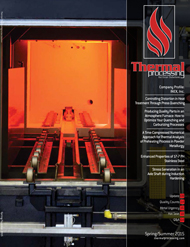Intensive quenching (IQ) is defined as cooling, usually using pure water, at a rate several times higher than the rate of conventional quenching. Fast, uniform part cooling reduces the probability of part cracking and distortion, while improving the surface hardness and durability of steel parts. Part I of this article (September 2014 Thermal Processing) discussed the history of the development of IQ, how it works, and how it compares with other quenching methods. This article covers IQ advantages and shows examples of parts that have been successfully produced using IQ.
Distortion resulting from quenching ferrous materials is caused by the non-geometrical transformation from austenite to martensite. Reduced distortion is achieved by:
- Quenching into hot oil; i.e., >250°F, or >120°C (moderate heat transfer)
- Press quenching in oil (high heat transfer with mechanical forced restriction)
- Quenching in hot salt bath (moderate to high heat transfer with interrupted cooling and no vapor barrier)
- High-pressure gas quenching, or HPGQ (moderate heat transfer, convection, with interrupted cooling)
- Intensive quenching, or IQ (extremely high heat transfer with interrupted cooling and no vapor barrier)
IQ is a patented, repeatable process that creates more uniform growth over the entire part geometry because the transformed case has a higher percentage of martensite (%%0415_HS_1%%). Growth uniformity is similar to that achieved with the white layer in nitriding.
IQ advantages
Oil, press, salt-bath, and high-pressure gas quenching methods are discussed in detail in the literature, but IQ might be considered counterintuitive, because quenching in water is associated with quench cracking. What is different about IQ?
Quench cracking is caused by non-uniform martensite transformation and/or high tensile stresses on the part surface. Intensive quenching forms a martensite shell on the part’s surface by way of vapor-less, uniform high-velocity water. The shell expands, creating a compression ring around the hot core, and as the core cools and its volume shrinks, it “pulls” the martensitic shell into even greater compression. Because the temperature difference between the part surface and its core is much greater in IQ than in oil, salt, or gas quenching, the potential compressive stresses are magnified.
IQ provides an additional advantage for carburized parts by shortening carburizing time. Because IQ’s heat transfer is so high, the ECD (effective case depth) is achieved using lower carbon levels. Typically, oil, salt, and gas quenching carburized alloy steels produce an ECD corresponding to a hardness of 50 HRC (Vickers 513) at a carbon level of 0.40%. Intensive quenching steel with the same carbon content produces a hardness of almost 56 HRC. In other words, the ECD can be achieved at 0.30% carbon, thus reducing the carburizing time. Therefore, this phenomenon has dramatically increased interest in the use of plain-carbon steels over alloy steels. In the majority of applications, the post temper surface hardness of 58 to 62 HRC is typical for carburized steels. The high quench severity of IQ enables neutral hardening of plain carbon steels; for example, IQ of AISI 1060 steel can achieve 61 HRC at over 95% martensite.
Another advantage of using IQ with plain carbon steels is the reduction of retained austenite. As the alloy content in steel increases, the martensite start and finish (Ms and Mf) temperatures are depressed, promoting an increase in retained austenite. Extremely fast quenching of 1060 steel (with no alloying additions) produces a simpler microstructure that limits the development of retained austenite. Carburized steel generally achieves 0.75 to 0.90% surface carbon, and carbon is one of the strongest austenite formers, followed by nickel, molybdenum, and manganese. If the surface carbon of plain-carbon steel can be kept lower, retained austenite can also be reduced.
Regarding my comparison in Part 1 to the market’s acceptance of HPGQ—which in many cases requires that a steel’s hardenability be increased—IQ’s ultrahigh heat transfer promotes the opposite; that is, reduction in alloy content for many components. Gear teeth are designed to withstand impact and to endure high loads. Therefore, the core of gear teeth must be ductile enough to absorb deflection. Using plain- and low-carbon steels satisfies that requirement by limiting the hardened depth in gears having fine-pitch teeth, which today are difficult to carburize without hardening the tooth core. The only traditional solution available to avoid that issue is a long nitriding process.
A few years ago, AFC-Holcroft provided IQ Technologies a large 36 in. x 72 in. x 36 in. UBQ batch carburizing furnace with an 11,000-gallon capacity water quench tank for the purpose of achieving IQ quench velocities. %%0415_HS_2%% shows an example of the size range that can be successfully quenched using IQ. Four 32-in. diameter spur gears were carburized and intensively quenched in the furnace. Due to the deep hardening of IQ, the carburizing cycle was reduced by 10 hours (about 33% of the time for conventional carburizing) to achieve the required ECD. The gears met the manufacture’s specifications for distortion and hardness among other parameters, and have been in operation nearly three years.
Heavy truck pinions, helical gears, and internal gears were also carburized and quenched in the furnace system. Due to confidentiality agreements between IQ Technologies and test-part owners, most results are proprietary, but all parameters including dynamic testing were positive. %%0415_HS_3%%, %%0415_HS_4%%, and %%0415_HS_5%% show some tests results from those pinions. Figure 4 shows the distribution of residual stress between oil-quenched and intensive quenched pinions. %%0415_HS_5%% is an example of the depth of hardening that can be achieved by intensive quenching.
I believe that for IQ acceptance by the early and late majorities (see %%0415_HS_1%%, Part I), it should be integrated with an austenitizing process, whether carburizing or straight hardening, that is established, thereby providing a “perfect marriage” for industry. While quenching one gear at a time is ideal for maximum distortion control, it may not meet higher production requirements. When improved distortion and higher production is a necessity, two options to consider are the material and the process:
- Higher alloy steels are more expensive, but are deeper hardening and produce increased levels of distortion when quenched too fast
- Low-cost alloys require a faster quench, and that usually includes liquids.
The compromise is a liquid that is easier to live with, and that is water.



























